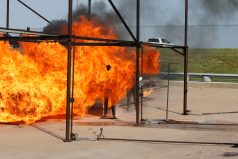
It is every employer’s goal to keep its workers safe on the job, but providing for the safety of your employees requires a holistic approach. Forming just one dimension of a hazard mitigation program, personal protective equipment (PPE) can be extremely beneficial when specified correctly. It is important, though, to look at a safety program comprehensively, so we asked our training experts, two of which will be attending the Petroleum Safety Conference at the end of this month, to share three key aspects to consider when building your program.
- Define your hazard — then protect against it. A key first step in protecting your employees is to clearly define and assess the thermal hazards within the workplace. A refinery may have different needs than an oil rig, so it is important to analyze your hazard situation with the guidance of consensus NFPA standards – NFPA 2113 for short duration thermal exposures from fire and NFPA 70E for arc flash. Once your hazards are defined, have a look at the hierarchy of risk controls to develop a comprehensive program for your employees to work in the safest possible environment.
- Know that your PPE needs may differ from situation to situation. Part of your protection program will likely include PPE. Whether your thermal hazard requires body PPE, face PPE, hand PPE or a combination of all three, specifying PPE is rarely one size fits all. Not all thermal hazards are the same, just as not all PPE is the same. Consider the difference between primary and secondary protection needs when assessing your situation.
- Primary protection PPE is designed for situations where significant exposure is likely to occur, including exposure to molten metal splash, radiant heat, flame, noise or flying particles.
- Secondary protection PPE, like daily FR apparel, is designed for situations where basic, continuous protection is needed in areas where intermitted hazard exposure is possible.
- Utilize PPE as a final layer of defense — not a suit of armor. According to the hierarchy of risk control, PPE is the last defense coming behind elimination, substitution, engineering controls and administrative controls measures. PPE cannot and should not be used as the only form of protection, nor is it an unbeatable barrier. PPE helps to shield a worker just long enough to remove him or herself from a thermal hazard source — not remain in it indefinitely. The FR fabric is the key component of the PPE and must be trusted to self-extinguish on day one and day 1001 to shield workers from the thermal hazards they face daily.
Canada’s premier oil and gas safety conference and tradeshow, the Petroleum Safety Conference (PSC) has connected health and safety experts, safety supervisors, and companies to the latest in health and safety knowledge, products and services. Westex by Milliken will be at booth #65 April 30 through May 2 – stop by to discuss your PPE program and how Westex can help best meet your needs.
